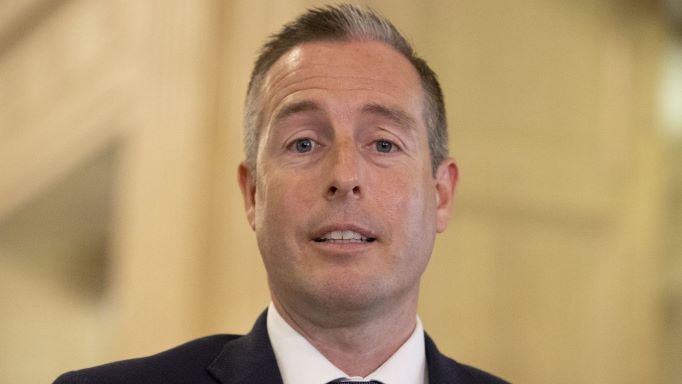
I turn to current events in today’s blog. I fully get this will not be everyone’s cup of tea, but there’s a lot happening on this side of the pond right now. Perhaps most pressing is the Russian troop buildup on the border of Ukraine. It seems pretty clear that Europe is holding its collective breath at the moment. Presidents, prime ministers and high-ranking officials have been visiting with Russian President Vladimir Putin and Ukrainian president Volodymyr Zalensky at a fair clip in recent weeks – Emmanuel Macron of France, Olaf Scholz of Germany, British Foreign Secretary Liz Truss and on and on. Even Irish Prime Minister (or Taoiseach, as he’s known here) Micheal Martin met with Zalensky recently.
In the distant past of late January, Scholz was on the fence about presenting a united front with his European counterparts. This is because Germany is so dependent on Russian natural gas and about to become more invested if plans for the completed Nord Stream natural gas pipeline are approved by German regulators. (It occurs to me that Russia with its long memory may be seeing this dependence as a source of smug payback for WWII. Just saying.) But this reliance on Russian gas is a continent-wide problem and is probably the biggest source of European angst at the moment. About 40 percent of the continent’s supply comes from Russia, and in the former Soviet bloc countries, that number hovers at 100 percent. Because of this, one commentator this week called that united front “thin.”
Last fall, Russia reduced its natural gas exports, setting off an energy crisis that made a significant dent in the pocketbook of rank-and-file Europeans. Here in Ireland, fuel and electricity prices have just gone through the roof. When I first came to Ireland, gas for the car was €1.40 a liter. It is now €1.77 and rising. That’s about $7.60 a gallon, folks. Some of the reasons for the spike were home-grown, but some can be traced right back to Europe. If Russia cuts off its natural gas spigot, the result would be disastrous. So sanctions if Russia invades Ukraine could become problematic. I read just recently that Russia is sitting on a $630B currency reserve and can sustain a reduction in revenue in the short term.
Diplomacy on a tightrope, for sure.
I can’t underscore how much this is seeping into the consciousness of Europeans. And the Irish. Ukraine leads the news every night. For someone not accustomed to war on native soil, it’s a bit disconcerting. Russia’s announcement that it was withdrawing troops from the border is viewed with jaded skepticism here. NATO and US defense ministers say to the contrary, troops are increasing. Language like “imminent danger” and “first war on European soil in 80 years” are being bandied about. And with the long memory of Europeans, the scars are still felt. There’s also a sense I pick up from over here that President Biden, stung by European criticism over withdrawing troops from Afghanistan, is perhaps engaging in over-zealous rhetoric in front of and behind the door.
Add to this energy crisis, exacerbated by Ukraine, there has been a meteoric rise in inflation – as you are all aware wherever you live. Here in Ireland, the inflation rate is 5 percent, close to the highest rate in the past two decades. It’s better than in the US, which stands at 7.5 percent as of this writing. The Irish government last week put forth a package of measures to help Irish citizens deal with this. Earlier this year, it announced it was paying €100 toward everyone’s electricity bill; it has now increased that amount to €200. Low-income households will receive a fuel allowance of €125. And the government lowered fares on public transportation by 20 percent. This plan brought a hailstorm of criticism from opposition parties, who said it was far too paltry a deal. But I don’t know. During COVID, every Irish citizen who qualified (both employers and employees) received a pandemic unemployment payment, with the average recipient receiving €300 a week. Spending for the PUPs has reached €9.1 billion, pretty much all of it borrowed and needing to be repaid. Now this package of inflation relief is added. I guess the government could always do more, but I am mindful of that bottom line.
Before I leave the world of war, I thought I would share one final observation. Back in late January, just as troops were amassing at the Ukrainian border, it was learned that for the first time in 20 years, Russians were planning to conduct military exercises 240 km off the coast of Cork in an area called the Irish ‘exclusive economic zone.’ The Irish government said the move was considered, while legal, ‘unwelcomed.’ After a flurry of Russian/Irish diplomacy and a planned protest by fishermen, the Russians agreed to move the location. BUT they moved just outside the zone and above the underground cables connecting the US to Europe. One Irish military expert opined: “The exercises will be over the cables – that is for sure. They are sending a message to the Europeans: we know where the cables are.”
I tell you this because Irish defense force leaders seized the moment to voice their concerns about the country’s military infrastructure, citing deficits in Ireland’s defense capabilities and a need for increased military spending. By way of background, the Republic of Ireland is a neutral country and not a member of NATO, and has been that way since its founding in 1921. In a case of interesting timing, a long-awaited report on the future of defense forces was released Feb. 9 – in the middle of all this talk of war and war games. The report recommends increase in pay across the board, increase in troop numbers, increase in cyber security, increase in naval presence, and on, to the tune of increased spending of 50 percent or more.
This situation is of more than a passing interest to me. When I learned of Ireland’s neutrality, it only served to heighten my interest in moving here. In my elder years, I strive to see both sides and there is probably a case to be made to beef up spending in key areas, like cyber security. But my personal opinion is that neutrality is a central tenet of Ireland’s identity, is enshrined in its constitution, is supported by the country’s people and should be maintained. Is there a sweet spot between doing nothing and becoming a military behemoth? Clearly. But what will be the cost? What budget line items go by the wayside to accommodate increased military spending? There’s a bottom line to consider here, too. It’s fair to say I will be watching this closely.
Northern Ireland

Paul Givan 
Jeffrey Donaldson
The Ukraine situation has pushed a lot of news to the back burner, not least Teflon Boris’s partygate scandal (for which I am sure he is ever so grateful). Closer to home, it has temporarily shifted public attention away from a game of political brinksmanship that has been unfolding in Northern Ireland. Stormont, in essence the NI legislative body, is in disarray, following the recent resignation of First Minister Paul Givan of the Democratic Unionist Party (DUP). It seems the DUP does not like the fact that post-Brexit renegotiations between Great Britain and the European Union over the Northern Ireland border were not going as fast or as swimmingly as it wanted. So what did it do? Givan resigned, which triggered the dismantling of the Stormont Executive – a “power sharing” group comprised of leaders of the five top political parties – forged as part of the Good Friday agreement. In other words, poof, no more executive branch.
Leaders from the other parties called the move “delusional,” as “creating a hostile and toxic environment,” and my personal favorite, from the leader of the Social Democratic and Labor Party: “Jeffrey (Donaldson, leader of the DUP) has been standing with a gun to his own head saying If you don’t give me what I want, I’ll shoot. And now he’s shot. It’s a farce.” The implications are far-reaching. A draft three-year budget can’t be implemented because it needs Executive approval; no new legislation can be introduced; and there’s a question of whether existing legislation is in jeopardy.
There is an election in May, and clearly the DUP felt that fears of the protocol would drive voters into its arms. But apparently…not. Consistently, polls have shown that the DUP is out of step with citizens, and a recent poll indicates the highest vote-getter at the moment is – wait for the drum roll – Sinn Fein. The ostensible party of NI Catholics, once the so-called political arm of the Irish Republican Army during the Troubles, and ultra-unionists’ (read political Protestants) greatest bugaboo is on tap to get the highest percentage of votes. Be careful what you wish for, eh?
I was frankly stunned when I read about Givan’s resignation. What party just decides that it is so important that it is going to throw an entire legislative body into chaos? The act may be suicidal, but it is also deeply, deeply disturbing. I know the American Congress sometimes feels like it sits on a knife’s edge, but there are checks and balances in place intended to halt a wholesale shredding of democracy. This situation in Northern Ireland feels different. This feels as if one party is holding an entire nation hostage.
And in the background is, of course, neverendingly, the Troubles. I know I’ve said this before in past blogs but it bears repeating – the sectarian, political and religious wounds of this island are not and may never be completely healed. It appears to me that the DUP was counting on those rifts when it made its decision; and who knows, really, what happens if Sinn Fein takes control in this back-and-forth tug? The party is also poised, according to polling, to lead in the Republic as well. What pendulum swings are in the offing then?
Housing

I am so fortunate that I rent a nice semi-detached home in my small rural town at a monthly payment that, while somewhat higher than I would like to ideally pay, is not unreasonable. Even here in this tiny hamlet, though, people were lined up the day it went on the market. One man, in the throes of a divorce, even offered to pay more than the asking rent. However, I think my delightful landlords concluded that an old female fart was their best bet.
When I say I am fortunate, I can not stress enough how much this is the case. I know wherever you live, and certainly in New England USA, where I am from, rental and/or purchase prices are crazy. But if you wanted, you could move to another part of the country with more modest housing costs. The thing about Ireland is that it’s an island nation, and you can’t run away from what is by all measures the worst crisis in generations. There is virtually not enough housing stock, either to purchase or to rent, and ipso facto, existing places are rising at an alarming rate.
Daft.ie (yes, daft, and the chuckle is appropriate), the website used by auctioneers (real estate agents) and private residents alike to advertise availability of rentals or purchases, last week released its quarterly rental housing report. Its conclusions were chilling. Dublin saw an 8.9 percent increase in rentals from Q4 2020 to Q4 2021, with an average cost per month of €2,056. That’s average. I’ve seen rooms in three- and four-bedroom apartments advertised for €1,200 a month or more. Meanwhile, the number of available units there collapsed, with only 712 rental ads as of Feb. 1 and 1,397 nationwide. Consider: an entire country with fewer than 1,400 places for rent. Can you now see why I say I am fortunate? While rents are not as high in the rest of the country, the percentage increase Q4 to Q4 is more alarming. In County Clare, where I live, the average rent was €1,087, an increase of 15.7 percent. Up in County Donegal, while the rental average was €826, that constituted a 24.3 percent increase year over year. All over the country, rents were up by double digits just about everywhere. (BTW, that €1,087 rental in Clare would be $1,245 in the US, based on the current exchange rate.)
Things are no better on the purchase end. This week, the governments’ Central Statistics Office issued a report that property prices across Ireland rose 14.4 percent in 2021 – with the average purchase price of a house in Dublin topping €500,000 ($565,820US). Again, while houses are less expensive once you leave the greater Dublin area, with an average cost of €326,457 ($369,300US), the percentage increase nationwide was higher — up 15.3 percent. I have a friend, a longtime resident of County Clare, who had been very focused on trying to buy something here and has essentially given up. She is seeing places she knows three years ago would have been worth €50,000 less and she just can’t bear to pay today’s asking prices. BTW, she sold her home in Ennis, our county seat, to a couple from Dublin who are largely working from home now – a demographic that is in part at the heart of housing increases countrywide.
The government launched a Housing for All plan to add as many 312,000 housing units by 2030, for people of all income levels. We’ll see. I guess this isn’t the first time the government has promised to do something about this only to see it watered down in the Dail (pronounced ‘dahl’ equivalent to Congress). Speaking of Sinn Fein’s increasing popularity in the Republic, it has hitched its wagon to the housing star in a big way. This has been a big hit with young people, many of whom can virtually not afford to move out of their childhood homes even if they are making a good wage. And college students? Let’s just say I would not want to be a college student anywhere in the country right now. Between housing costs and COVID, these people have really been deprived. And many will likely join their older siblings in simply leaving Ireland for greener pastures. Another Irish diaspora, as if this country needed another.
Well, time to wrap this up. If you’ve actually read to this point, congratulations! You’re as much a newshound as I am. I hold it against no one who gave up mid-read. We media junkies are a rarified breed, for sure. BTW, I depart next month for Rwanda to visit my daughter, with a stop on the way back to Amsterdam for two days to see the tulip gardens in bloom. I am very much looking forward to the trip. So stay tuned…

Reader Comments
Hi Debbie
Read every word of your blog. I am a news junkie. Very interesting and parallels stateside in real estate. My youngest is buying her first home. 1400 ft
$285k
Guess thatd be 2 mill in san fran!
My oldest lives with me and can’t project having her own home ever. Saddens me.
Middle daughters inlaws moved to NC from Ct in August and can not find a house to buy. Rentals are proliferating tho.
Its dire.
Well take care. Enjoy your travels!
Ever read Kisses for Katie?
About an 18 yr old American who moved to Rwanda (I think) some years back. By 21 she had adopted 14 girls. Wonderful true story.
I read the whole thing! XXOO
I too keep up with all that is happening in this world on a daily basis and am equally concerned. It’s amazing how few Americans I know who do. Wonderful read once again! Dan and I will be in Ireland the month of May. We should get together. Email me your phone number so we can make plans once we’re there!
I made it to the, also! You did more balanced reporting of the situation than any of major news outlets. (I don’t consider bias because I believe it’s human to be bias in some way). It’s a complicated world and there is also Chine and Korea to consider. Let’s just say good luck to us. Can’t wait to hear about your trip.
Just read your synopsis of world events, or “Troubles” redux….we sure are all in this together, aren’t we? An interesting tidbit about real estate in our neck of the world….New York Sate is including, in their new budget (sliding it by the average voter without debate), authorization for accessory buildings on every person’s property as well as giving the ok for anyone within a half mile of a train station to develop housing units on an acre….will change the flavor of many sleepy little hamlets, for sure. How would that go over in County Clare? But maybe it’s an unavoidable solution to the real housing crisis in this country and elsewhere? Thanks for sharing, Deb, and I look forward to your Rwanda tales.
Thank you for your blog. I appreciate the Irish point of view and I am interested in hearing about your travels, Amsterdam is on my bucket list. Would love to travel this summer but now a war to think about after Covid! What a restless world. Stay safe.
Yes, as a fellow news junkie, I read every word. I found the different viewpoint really interesting. We don’t often get to view any lens outside of our own. Best, Karen
As always, I can never pause reading your blogs once I start! I agree with John O’Reilly!
Now, I have to go back and read again, since there was so much to absorb and contemplate, dearest Sis!
Oh, the joy of Rwanda for you! Big hugs for Bridget and Tom please, and huge smiles thinking of Fernwood Cove, Maine! :):):)
Love you to the moon and back, Do
Deborah, thanks for your insight, all of it. Jack and I watched Belfast last night, and it brought back all the precariousness that Ireland lives with. Enjoy your trip. We look forward to summer and the wedding.
Thank you to everyone who has taken the time to share your thoughts. I guess there are more news towns around than I anticipated! It is really good to hear from you all. Slainte
Great blog and so informative! We tend to think only of the troubles in our own back yard, but now the globe seems to be a backyard full of troubles, too. What’s next constantly comes to mind and I truly fear what really is next. We send best wishes for you to thoroughly enjoy your trip next month and look forward to another great read. Spring will be coming to us all and my hope and prayer is that it brings sunshine and good news rather than the gloom we are all experiencing this winter. Marti
Well done Deborah, a great synopsis of where things are at presently in Europe… some wonders between the woes! I hope we get to see you before you head off to Rwanda, for your next adventure. Keep well. Xx
A must: when in Amsterdam, visit Keunkenhof Gardens just outside the city.
I reread your blog today and answered twice but it was lost?! Talk to you tomorrow, Deborah!
Talk to you tomorrow, Deborah!